Der FC St. Pauli gewinnt in beeindruckender Manier beim 1. FC Heidenheim. Nach einer schwachen ersten Halbzeit, in der Heidenheim vor allem defensiv zu gefallen wusste, zerlegte der FCSP seinen Gegner kurz nach der Halbzeit dank einer Leistungssteigerung in seine Einzelteile. Spätestens nach diesem Spiel und in dieser Form ist dem FC St. Pauli in dieser Saison alles zuzutrauen.
(Titelbild: imago images/via OneFootball)
Die Aufstellung
Wie erwartet gab es beim FC St. Pauli keine Veränderungen in der Startelf. Ich hatte im Vorbericht vermutet, dass es, wenn überhaupt, einen Startelf-Einsatz für Becker oder Dittgen geben könnte. Dem war aber nicht so. Timo Schultz vertraute der gleichen Elf wie auch schon vor der Länderspielpause gegen Dresden.
Beim 1. FC Heidenheim hingegen gab es gleich mehrere Veränderungen: Top-Angreifer Tim Kleindienst fehlte leicht angeschlagen in der Startelf und kam erst in der 2. Halbzeit. Für ihn startete Stefan Schimmer. Auch Denis Thomalla und Robert Leipertz mussten die Startelf im Vergleich zum 0-3 gegen Werder Bremen verlassen. Kevin Sessa und Dženis Burnić kamen für die beiden rein.
Zudem stellte Trainer Frank Schmidt sein Team anders auf den Platz, als üblich. Hatte ich im Vorbericht behauptet, dass die defensive Viererkette die einzige Konstante in der Spielidee von Schmidt ist? Ha, da könnt ihr mal sehen, wie wenig Ahnung ich von sowas habe. Der 1. FC Heidenheim startete nämlich in einem 3-5-2.

Ungewohnt: Ein frühes Gegentor
Lange brauchte es nicht, bis klar wurde, was den 1. FC Heidenheim zu einem so unangenehmen Gegner macht: Von der ersten Minute an war mächtig Radau auf dem Platz. Dem FC St. Pauli blieb anfangs wenig bis gar keine Zeit um Entscheidungen zu treffen. Heidenheim presste hoch, sehr gut abgestimmt im Verbund und mit viel Tempo.
Und das 3-5-2 von Heidenheim machte sich direkt bezahlt: Denn das Team von Frank Schmidt konnte hoch pressen ohne defensiv in Unterzahl zu geraten. Bei Ballbesitz in den hinteren Reihen des FC St. Pauli schoben die beiden Flügelverteidiger raus auf die Außenverteidiger des FCSP (allerdings nur, wenn der Ball auf der entsprechenden Seite war). Von den beiden Achtern, Sessa und Burnić, schob einer auf Aremu und einer auf die Halbposition, je nachdem auf welcher Seite der Ball war. Die beiden Stürmer gingen auf die Innenverteidiger rauf.
Mit diesem Konzept und ordentlich Dampf konnte Heidenheim den FC St. Pauli im Spielaufbau gehörig unter Druck setzen. Klappte das nicht, standen weiterhin vier defensive Spieler gegen das offensive Dreieck bestehend aus Buchtmann, Kyereh und Burgstaller. Die Überzahl war möglich, da Heidenheim den ballfernen Außenverteidiger des FCSP nicht bewachte. Der FC St. Pauli hätte somit immer die Option gehabt über eine schnelle Verlagerung aus dem Pressing kontrolliert heraus zu kommen. Aber mach das mal, wenn ein Team so gut im Verbund gegen dich presst.
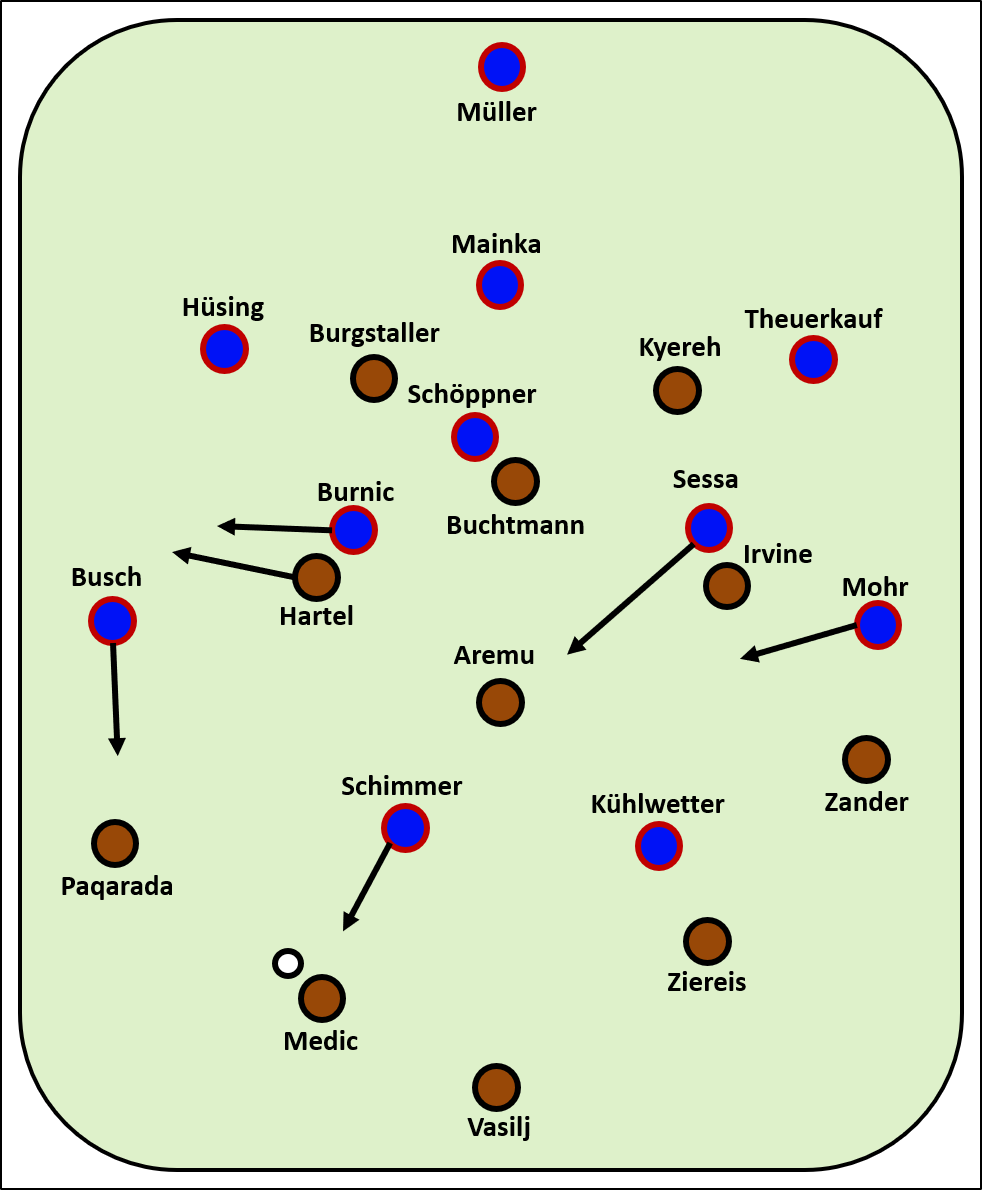
Wie gut das funktionierte, konnten wir dann bereits in der 3. Minute bestaunen: Medić spielte links zu Paqarada, der sofort aggressiv von Marnon Busch angelaufen wurde und den Zweikampf verlor. Über Schimmer gelangte der Ball ins Zentrum, wo Vasilj unglücklich in die Zentrale abwehrte und der von links eingerückte Mohr ins verwaiste Tor einschieben konnte.
Damit fing sich der FC St. Pauli zum ersten Mal in dieser Saison ein Gegentor innerhalb der ersten 30 Minuten, also in einer Spielphase, in der üblicherweise immer der FCSP die Oberhand hatte.
Erneute Erkenntnis: Spielkontrolle ungleich Überlegenheit
Diese Dominanz in der Anfangsphase, die den FC St. Pauli zuletzt auszeichnete, war gegen Heidenheim nicht vorhanden. Die frühe Führung war für das Heidenheimer Spiel natürlich pures Gold. Sie zogen sich in der Folge zurück und überließen dem FC St. Pauli Raum in der eigenen Hälfte. Aber der viele Ballbesitz stellte eher Gefahr für den FCSP dar, als das dadurch gute Situationen entstanden. Denn Heidenheim verstand es, den Raum in der eigenen Hälfte zu beherrschen und dort die Bälle zu gewinnen, wo es für den FC St. Pauli am gefährlichsten war: Immer wieder zog sich die Schlinge in den Halbräumen zu und aus dieser Position konnte Heidenheim schnell umschalten. Der FC St. Pauli tappte aber auch oft genug in eben jene Falle hinein. Es gelang viel zu selten auf der Außenbahn hinter die beiden Flügelverteidiger zu gelangen.
Gerade in der ersten Halbzeit wurde deutlich, warum Heidenheim als eines der besten Defensiv-Teams der Liga gilt. Besonders, wenn dieses Team wenig aus seinen Positionen rausrücken muss, ist es enorm schwer sich Chancen zu erspielen. Timo Schultz betonte auf der Pressekonferenz vor dem Spiel, dass es darauf ankommt, dass Heidenheim aus seinen Positionen gelockt und in Bewegung gebracht wird. Wie schwer das ist, konnte dann auch der FC St. Pauli in der ersten Halbzeit am eigenen Leib erfahren.
Ich persönlich habe mich ein wenig gewundert, dass Heidenheim nach der frühen Führung so tief stand. Denn das hohe Pressing zu Beginn war ziemlich erfolgreich und hätte womöglich noch mehr Erfolg bringen können. Klar, das ist laufintensiver als tief zu stehen. Aber so hatte der FC St. Pauli die Möglichkeit, sich nach dem Rückstand ein wenig „freizuspielen“, wie Timo Schultz es nach der Partie nannte.
Mit dem 3-5-2 reagierte Heidenheim recht gut auf das Anlaufverhalten des FC St. Pauli. Durch die drei Innenverteidiger und zwei Außenverteidiger auf dem Platz hätten sie gegen das übliche Anlaufverhalten des FCSP eine Überzahl im Aufbau erzeugen können. Denn Burgstaller und Kyereh hätten beim Anlaufen drei Spieler gegen sich gehabt. Und in Unterzahl kannst Du im Pressing nur selten Druck entwickeln. Eine im wahrsten Sinne des Wortes zentrale Rolle hatte hierbei Christopher Buchtmann. Der löste sich immer mal wieder aus seiner Zehnerposition und lief den zentralen Innenverteidiger an. So konnten Burgstaller und Kyereh auf die äußeren Außenverteidiger schieben. Die Flügelverteidiger Mohr und Busch wurden, wie üblich, anfangs von den Halbpositionen des FCSP angelaufen. Je länger das Spiel dauerte, umso häufiger waren es aber die eigenen Außenverteidiger, die diesen Job übernahmen.
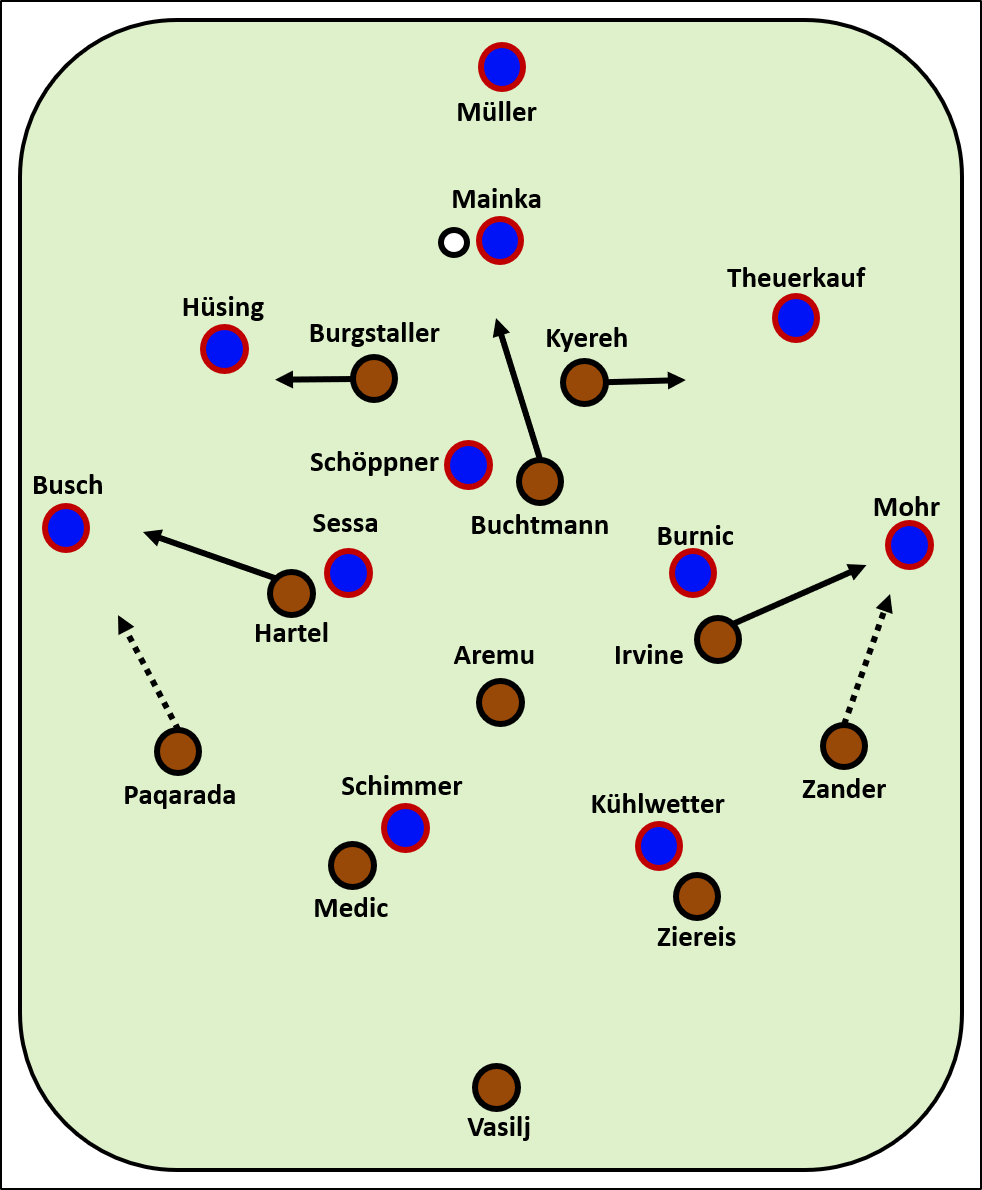
Grundsätzlich war dieses Anlaufverhalten mit Buchtmann zwischen den Stürmern aber eine ziemlich maue Nummer. Meist startete der FCSP (zu) spät und mit (zu) wenig Tempo, sodass Heidenheim nur selten dabei unter Druck geriet. Sowieso befreite sich Heidenheim häufig einfach mit einem langen Ball.
Spielentscheidend waren, wie nicht anders vermutet werden konnte, die Ballverluste und die Verhaltensweisen in den Umschaltmomenten. Im Verlauf der ersten Halbzeit gelang es dem FC St. Pauli zunehmend besser die Positionsangriffe zu Ende zu spielen. Die Anzahl der gefährlichen Ballverluste reduzierte sich dadurch deutlich.
Eine wichtige Rolle nahm zum Ende der ersten Halbzeit Afeez Aremu ein. Der war nicht selten das Ende eines gebildeten Dreiecks zwischen einem Innenverteidiger und einem Spieler auf der Halbposition. Die Formation der Heidenheimer bot dem FC St. Pauli zwar wenig Raum auf den Außenbahnen und es gelang auch selten den Ball in die wichtige Zone „hinter den Flügelverteidiger“ zu bringen. Aber je länger die erste Halbzeit lief, umso häufiger gelang es Afeez Aremu zentral freizuspielen, also in einer arschgefährlichen Zone für Heidenheim. Aremu machte einmal mehr defensiv ein gutes Spiel im FCSP-Trikot, aber offensiv kann er noch ein paar Schritte machen (ich bin überzeugt davon, dass er das machen wird – gestern hatte er so viele Ballaktionen wie noch nie beim FCSP und er sucht diese inzwischen auch viel aktiver). Allerdings war das ja auch nur die erste Kette, die damit überspielt wurde. Die Defensive der Heidenheimer zog sich in der Folge noch enger zusammen und bot dem FC St. Pauli noch weniger Raum. Aremu hatte entsprechend wenige Optionen, trotz seiner zentralen Position.
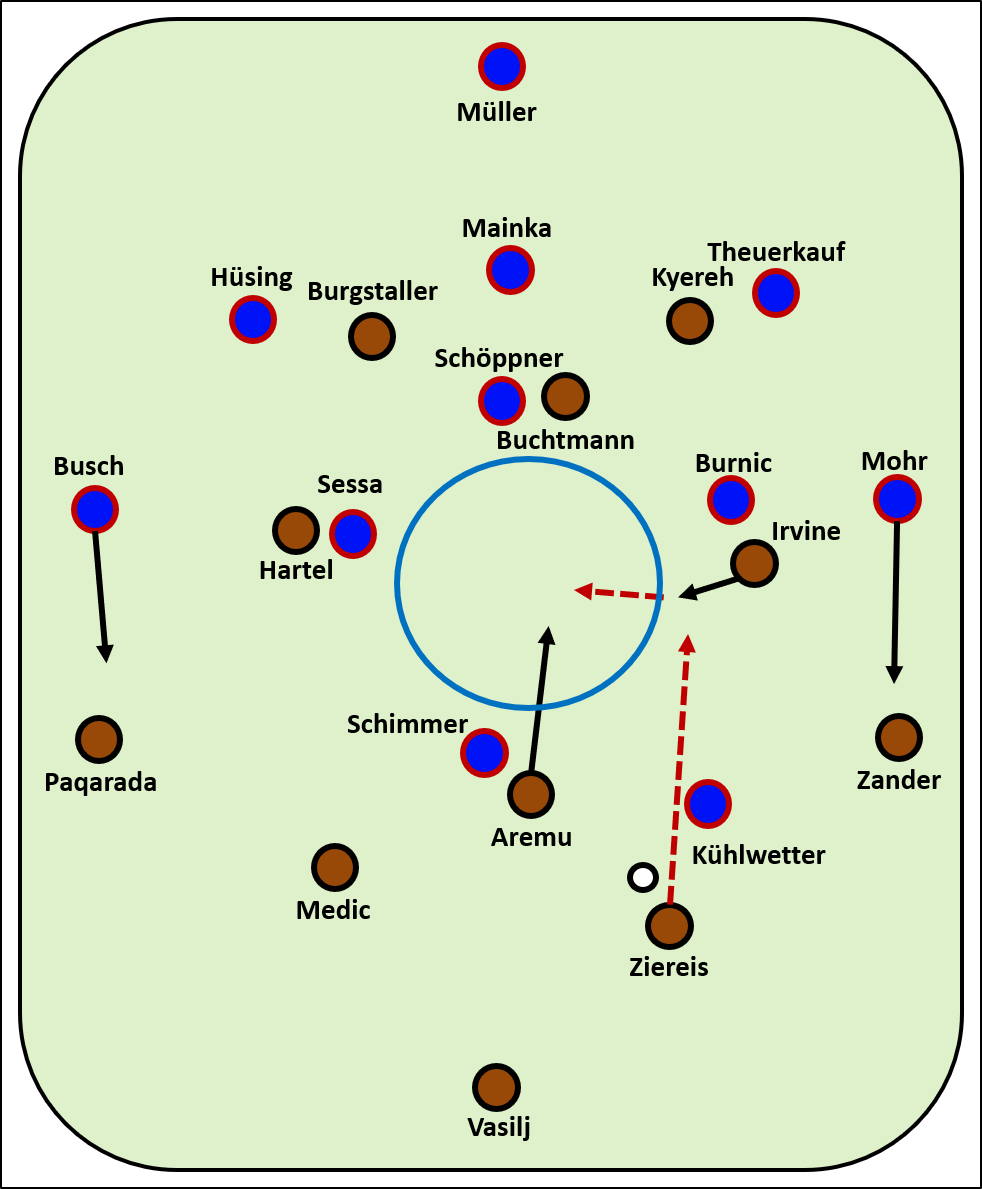
Auch wenn das Spiel des FC St. Pauli zum Ende der ersten Halbzeit ausgeglichen war, hatte Heidenheim insgesamt klar die besseren Torchancen. Fast alle diese Chancen entstanden aus Ballverlusten des FC St. Pauli. Ich habe keine einzige Torchance für Heidenheim aus dem eigenen Aufbauspiel heraus gezählt. Während sich der FCSP also darum bemühte den Ball kontrolliert vor das Tor der Heidenheimer zu bekommen, versuchten diese aus den Ballgewinnen immer schnell umzuschalten, was nicht selten gelang. Ein Grund dafür war auch, dass der FC St. Pauli die Bälle nicht nur zu häufig verlor. Sie gewannen sie auch viel zu selten direkt wieder zurück.
2.Halbzeit: Release the Kraken!
Ich schreibe es mal ganz ehrlich: Das Gegenpressing und allgemein der Druck auf die ballführenden Gegenspieler war scheiße vom FC St. Pauli in der ersten Halbzeit. Klar, die Anzahl der Ballverluste auch. Aber wenn Du die dann nichtmal teilweise direkt wiederholst, dann ist es doppelt bitter. Gegen Heidenheim war es weniger die Positionierung, sondern eher das Verhalten nach Ballverlust. Da fehlte es schlicht an Tempo.
Tempo kam dann nach der Halbzeit mit Maximilian Dittgen ins Spiel, der Christopher Buchtmann ersetzte. Ich möchte die Verbesserungen im Spiel des FC St. Pauli aber nicht (nur) an Dittgen festmachen. Eine leichte Umstellung im Anlaufverhalten war vorhanden, ja. Aber es war dann doch das, aus meiner Sicht, deutlich veränderte Verhalten nach Ballverlusten bzw. Ballgewinnen. Fünf seiner bis dahin neun Gegentore hatte Heidenheim nach eigenem Ballverlust gefangen (Höchstwert der Liga). Nach diesem Spiel sind es 9 von 13.
Das, was dem FC St. Pauli zu diesen rauschhaften fünf Minuten mit drei Toren verhalf, zu der Befreiung des Kraken, war das eigene Gegenpressing bzw. die Gier nach dem Ball und dem anschließenden Umschaltverhalten. Dieses unmissverständliche „Gib uns den Ball wieder, Du Arsch!“, was auch den 1. FC Heidenheim auszeichnet, war spielentscheidend.
Durch dieses aggressive Pressing von Zander und Aremu konnte Marcel Hartel in der 55.Minute den Ball auf der rechten Seite zurückerobern und auf Jackson Irvine weiterleiten. Sofort entwickelte sich enormes Tempo. Irvine chippte auf Burgstaller, dessen erster Kontakt war Weltklasse, der zweite dürfte übermorgen bereits im Museum of Modern Arts ausgestellt werden und der dritte ist der eines klassischen Torjägers – 1:1!
Ne Minute später ist es auf der gleichen Seite wieder Irvine, der den Ball bekommt, weil Heidenheim unter Druck gesetzt wurde und den Ball nicht richtig klären kann. Schnell Burgstaller angespielt, der flankte von rechts rein, Dittgen am ersten Pfosten glockenfrei – 2:1. BÄM!
Auch das dritte Tor fällt nach Heidenheimer Ballverlust oder besser gesagt einem starken (und fairen!) Ballgewinn von Marcel Hartel. Auch bei diesem Tor ist es das Verhalten direkt nach Ballgewinn, das entscheidend ist: Dittgen zieht sofort auf der Außenbahn durch und nur deshalb kann Hartel direkt den Konter initiieren.
Könnt ihr euch an drei FCSP-Tore innerhalb von fünf Minuten erinnern? Hat es sowas jemals gegeben? Ich kann es nicht. Aber scheiße ja, ich will mehr davon! Der FC St. Pauli stellte das Spiel binnen weniger Minuten komplett auf den Kopf.
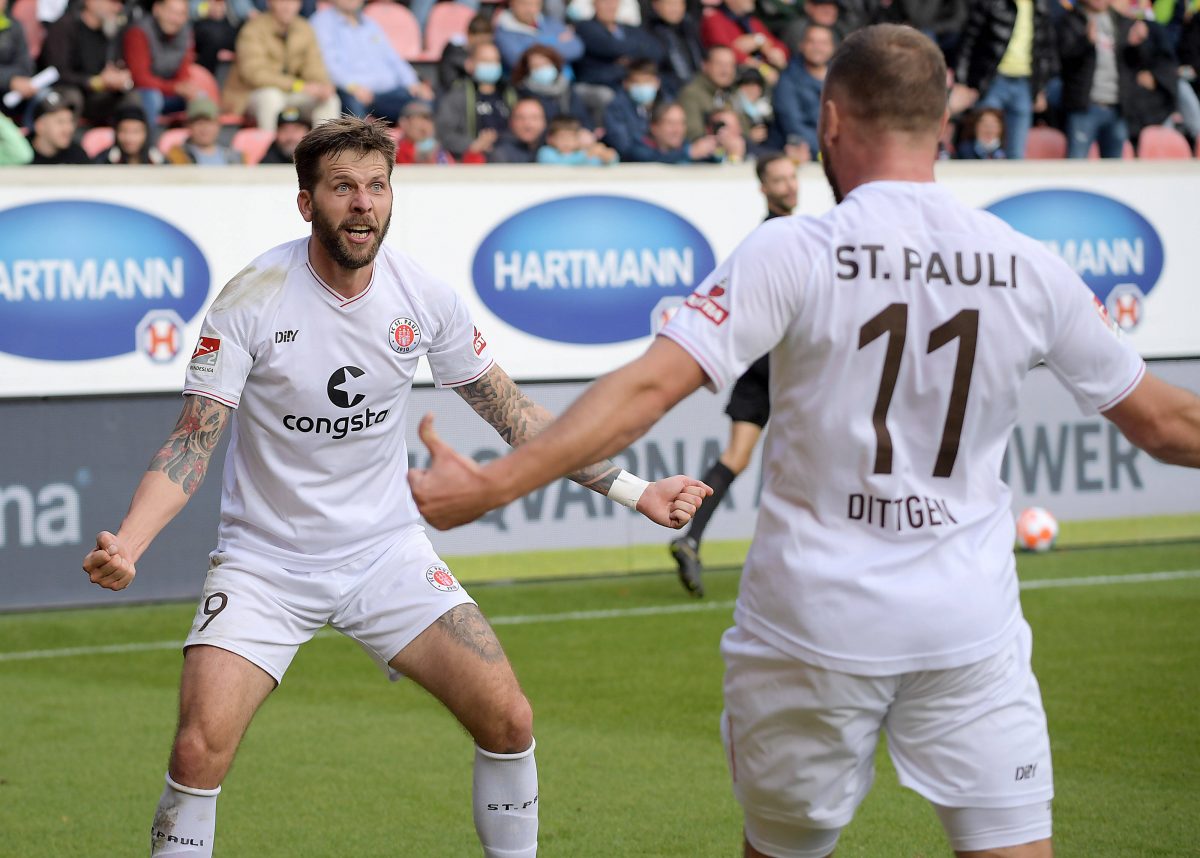
(imago images/via OneFootball)
Bevor wir jetzt aber alles über den grünen Klee loben: Es handelte sich weiterhin um ein recht ausgeglichenes Fußballspiel. Mit dem Unterschied allerdings, dass der 1. FC Heidenheim aus seinen Ballgewinnen in der ersten Halbzeit weniger machte, als der FC St. Pauli in der zweiten.
Nachdem Heidenheim aber die Schockstarre aufgrund der drei Gegentore mit der Einwechslung von Tim Kleindienst abgelegt hatte, kamen auch wieder Chancen für sie. Der FC St. Pauli wirkte zwar stabil, aber hatte selbst gezeigt wie schnell ein Spiel gekippt werden kann. Philipp Ziereis (90% am Boden, 100% in der Luft gewonnen) und Jakov Medic waren aber vor allem in der 2.Halbzeit stabil.
Das, was den FC St. Pauli in der 2.Halbzeit auszeichnete, war nichts anderes als das, was Heidenheim seit Jahren spielt. Dieser krasse und seit Jahren immer weiter verbesserte Fokus auf die Momente des Ballbesitzwechsels macht das Team von Frank Schmidt so erfolgreich. Sechs Tore kurz nach eigenem Ballgewinn hat Heidenheim bis gestern erzielt. Nun sind es acht. Sechs Tore sind in diesem Spiel gefallen. Alle aufgrund von Ballverlusten bzw. Ballgewinnen und Umschaltmomenten. Wenn es noch eines Beweises bedurft hätte, wie wichtig das Verhalten in den Umschaltmomenten ist, muss nur das gestrige Spiel angeschaut werden.
Der FC St. Pauli glänzte in den letzten Spielen mit teils überragender Dominanz und Spielkontrolle. In Heidenheim hat er gezeigt, dass es auch ohne geht und dieses Team in offensiven und defensiven Umschaltmomenten eine ebenso große Wucht entfalten kann, wenn es nötig ist. Vier Tore gegen die bis dahin beste Defensive der Liga sind vielleicht etwas hoch (xG: 2.2 – 1.5 pro FCSP), aber trotzdem mehr als ein Statement.
Allerdings zeigte das Spiel auch wieder, dass der FC St. Pauli nicht nachlassen darf sondern immer auf Anschlag spielen und arbeiten muss, um erfolgreich zu sein. Was aber schon fast beängstigend ist: Wenn das Team diese 100% abruft, und sei es nur eine Halbzeit, dann sind sie aktuell unschlagbar.
Immer weiter vor!
//Tim
Alle Beiträge beim MillernTon sind gratis. Wir freuen uns aber sehr, wenn Du uns unterstützt.
MillernTon auf BlueSky // Mastodon // Facebook // Instagram // Threads // WhatsApp // YouTube
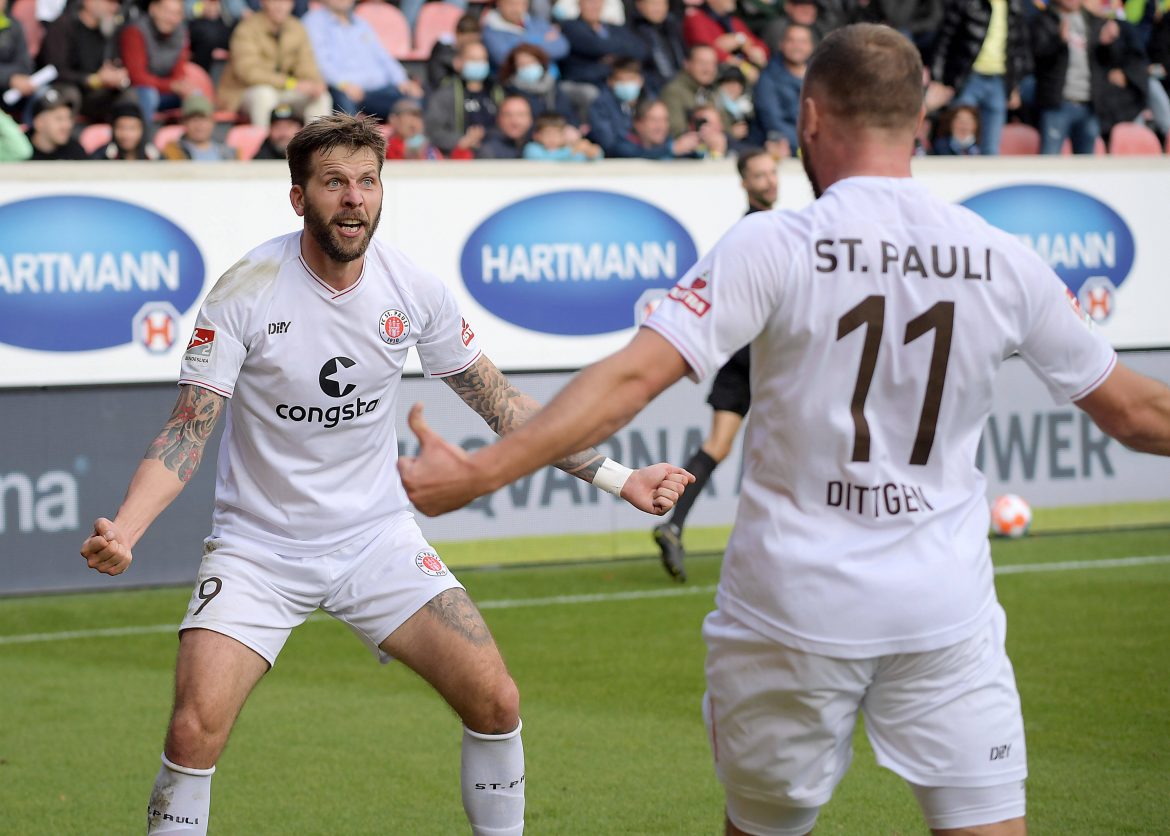

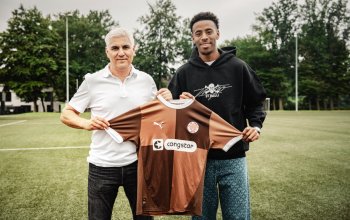


Danke für den emotionalen und analytisch feinen Kommentar, Tim! Der Beginn der zweiten Hälfte fühlte sich im Stadion an wie ein Rausch, hoffentlich bewahren sich die Jungs diese Gier. Forza!
Ich muss die ganze Zeit grinsen und kichern, während ich diesen Artikel lese. Das macht alles so einen Spaß gerade … das ist geiler wie 09/10, und das war schon verdammt geil.
Der FC St. Pauli wird langsam zum Angstgegner für den 1. FC Heidenheim, Maik hat die verdiente TV-Präsenz (immerhin kurz) und endlich wieder Tims Analysen. Sooo schön gerade alles.
Moin Schönes Fazit,
Mir bereitet gerade nur Unser Tabellenplatz etwas Sorge, da wir gerade zu weit dem 4. Platz enteilt sind ;-)… und dann KonzernMannschaften vielleicht demnächst am Millerntor empfangen werden müssten… ganz ehrlich … ich möchte so ein GeldSzenario nächste Saison nicht erleben… auch bei den TicketPreisen…
Eher sollten wir dann Unseren Frauenfußball deutlich besser fördern…
Meine Meinung ( und Eure?!)
Meine Meinung? Aufstieg jetzt. Darum geht es im Fußball. Und besser wir als Kühne, Gazprom, Wiesenhof, Kind. Ich möchte gerne mit einem (wenn auch kleinem) Gegenentwurf Meister werden.
Das nimmt nicht weg, dass der Frauenfußball noch besser gefördert werden sollte. Aber auch das geht dann besser, wenn Geld aus der ersten Herren Liga generiert wird.
You got it,Bro!!
Topp Artikel!!!
Flanke vorm 2-1 von Kyereh, oder?
Jetzt noch 18 Punkte zum Nicht-Abstieg holen, dann einmal durchatmen und jedes Spiel gewinnen wollen. Die Liga ist sooooo eng bei einander.
Wurde schon mal soo ein gepflegter Ball im Millerntor gespielt?! Und dann scheint von außen betrachtet, auch noch ne gute Stimmung und Anspruchhaltung innerhalb der Mannschaft gepflegt zu werden, echt guut.
FORZA FORZA FORZA